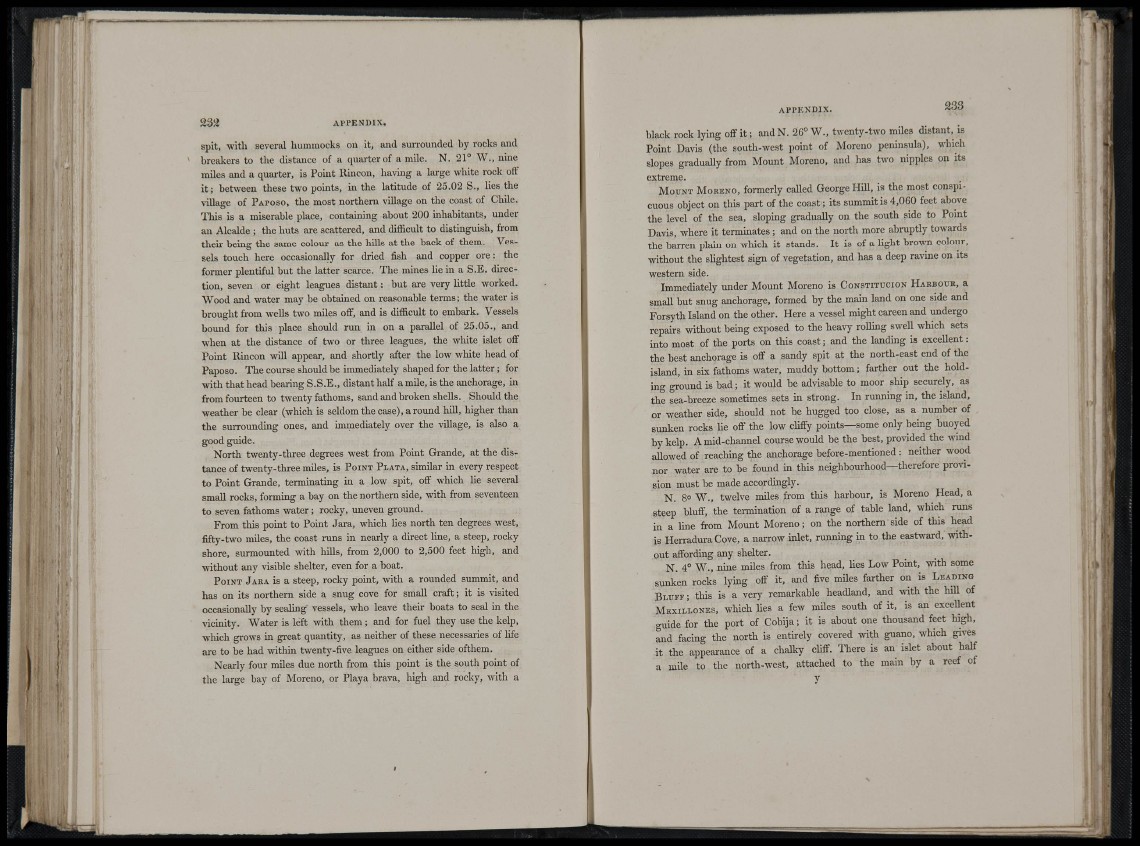
Í5 " •• : •: : .f2l
I.
1 1
i
i
I I
. Í
tt
K II
' li
2 3 a A P P E N D I X .
spit, -witli several hummocks on it, and sun-ounded by rocks and
breakers to the distance of a quaiterof a mile. N. 21° W., nine
miles and a quarter, is Point Rincón, having a large white rock oft'
i t ; between these two points, in the latitude of 25.02 S., lies the
village of PAPOSO, the most northern village on the coast of Chile.
This is a miserable place, containing about 200 inhabitants, under
an Alcalde ; the huts are scattered, and difficult to distinguish, from
their being the same colour as the hills at the back of them. Vessels
touch here occasionally for dried fish and copper ore: the
former plentiful but the latter scarce. The mines lie in a S.E. direction,
seven or eight leagues distant: but are very little worked.
Wood and water may be obtained on reasonable terms; the water is
brought from wells two miles off, and is difficult to embark. Vessels
bound for this place should run in on a parallel of 25.05., and
when at the distance of two or three leagues, the white islet off
Point Rincón will appear, and shortly after the low white head of
Paposo. The course should be immediately shaped for the latter; for
with that head bearing S.S.E. , distant half a mile, is the anchorage, in
from fourteen to twenty fathoms, sand and broken shells. Should the
weather be clear (which is seldom the case), a round hill, higher than
the suiToxmding ones, and immediately over the village, is also a
good guide.
North twenty-three degrees west from Point Grande, at the distance
of twenty-three miles, is POI NT P L A T A , similar in every respect
to Pomt Grande, terminating in a low spit, ofi^ which lie several
small rocks, forming a bay on the northern side, with from seventeen
to seven fathoms water; rocky, uneven ground.
From this pohit to Point Jara, which lies north ten degrees west,
fifty-two tmles, the coast runs in nearly a direct line, a steep, rocky
shore, surmounted with hills, from 2,000 to 2,500 feet high, and
without any visible shelter, even for a boat.
P O I N T J A R A is a steep, rocky point, with a rounded summit, and
has on its northern side a snug cove for small craft; it is visited
occasionally by sealing vessels, who leave their boats to seal in the
vicinity. Water is left with them ; and for fuel they use the kelp,
which grows in great quantity, as neither of these necessaries of life
are to be had within twenty-five leagues on either side ofthem.
Nearly four miles due north from this point is the south point of
the large bay of Moreno, or Playa brava, high and rocky, with a
' > (
A P P E N D I X . 2 3 3
black rock lying off i t ; and N. 26° W„ twenty-two miles distant, is
Point Davis (the south-west point of Moreno peninsula), which
slopes gradually from Mount Moreno, and has two nipples on its
extreme.
M O U N T MO R E N O , formerly called George Hill, is the most conspicuous
object on this part of the coast; its summit is 4,060 feet above
the level of the sea, sloping gradually on the south side to Point
Davis, where it terminates; and on the north more abruptly towards
the barren plain on which it stands. It is of a light brown colour,
without the slightest sign of vegetation, and has a deep ravine on its
western side.
Immediately under Mount Moreno is CONS T I TUC IÓN HA R B O U R , a
small but snug anchorage, formed by the main land on one side and
Forsyth Island on the other. Here a vessel might careen and undergo
repairs without being exposed to the heavy rolling swell which sets
into most of the ports on this coast; and the landing is exceUent:
the best anchorage is ofiF a sandy spit at the north-east end of the
island, in six fathoms water, muddy bottom; farther out the holdmg
ground is bad; it would be advisable to moor ship securely, as
the sea-breeze sometimes sets in strong. In running in, the island,
or weather side, should not be hugged too close, as a number of
snnlcen rocks lie off the low cliffy points—some only being buoyed
by kelp. A mid-channel course would be the best, provided the wind
allowed of reaching the anchorage before-mentioned : neither wood
nor water are to be found in this neighbourhood—therefore provision
must be made accordingly.
N. 8" W., twelve miles from this harbour, is Moreno Head, a
steep bluff, the termination of a range of table land, which runs
in a line from Mount Moreno; on the northern side of this head
is Herradura Cove, a narrow inlet, running in to the eastward, without
affording any shelter.
N. 4° W., nine mUes from tliis head, lies Low Point, with some
sunlcen rock's lymg off it. and five mües farther on is L E A U I N G
BLUFF; this is a very remarkable headland, and with the hill of
MEXILIONES, which lies a few miles south of it. is an exceUent
guide for the port of Cobija; it is about one thousand feet high,
and facing the north is entirely covered with guano, which gives
it the appeai-ance of a chalky chff. There is an islet about half
a mile to the north-west, attached to the main by a reef of
y
I' I IF.
I U I
• ' f
! r-1